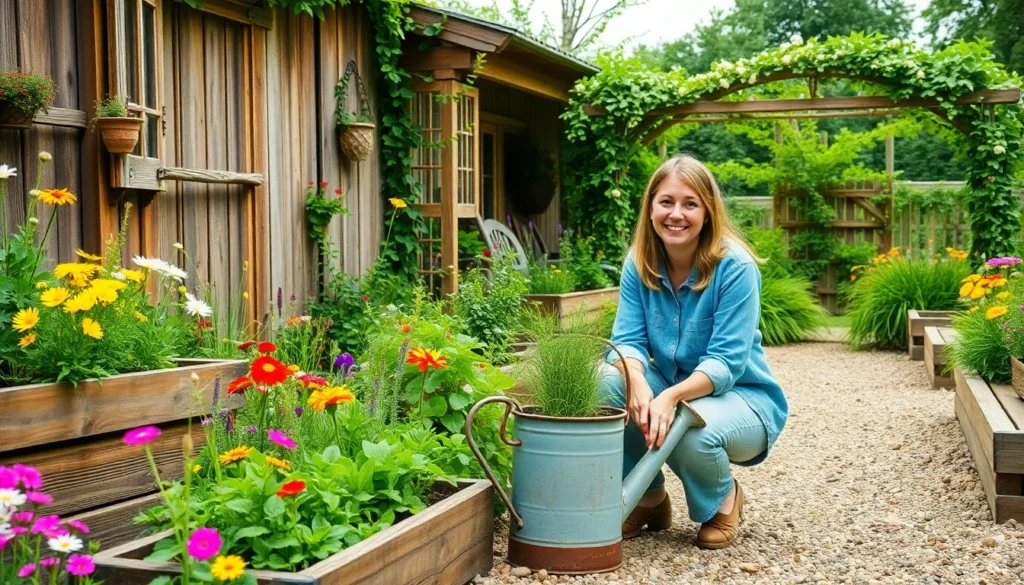We’ve all dreamed of creating that perfect country garden – a charming outdoor space that feels like a peaceful retreat from our busy lives. There’s something magical about the rustic beauty of wildflowers swaying in the breeze combined with weathered wooden fences and stone pathways that instantly transport us to simpler times.
Whether you’re working with sprawling acres or a modest backyard we can help you transform your space into a stunning country paradise. From choosing the right cottage plants to incorporating vintage elements that’ll make your neighbors green with envy the possibilities are endless when you embrace the relaxed elegance of country garden design.
The best part? Country gardens aren’t just beautiful – they’re surprisingly low-maintenance once established. We’ll share practical tips that’ll have you creating Instagram-worthy garden scenes while actually spending less time on upkeep and more time enjoying your outdoor sanctuary.
Country Garden Ideas That Create Rustic Charm and Natural Beauty
We’ve gathered the most effective country garden design approaches that transform ordinary outdoor spaces into enchanting rustic retreats. These proven techniques blend natural elements with charming vintage touches to create gardens that feel both timeless and inviting.
Incorporate weathered wood elements throughout your garden design. Reclaimed barn doors make stunning garden gates, while old fence posts create perfect supports for climbing roses and clematis vines. We recommend using cedar or oak pieces that develop beautiful patina over time, adding authentic character to your country garden industry.
Plant cottage garden favorites in informal groupings. Hollyhocks, foxgloves, and delphiniums create vertical interest when planted against rustic fencing or stone walls. Mix these tall perennials with lavender, catmint, and salvia for continuous blooms from spring through fall, ensuring your garden maintains color throughout the growing season.
Create winding gravel or crushed stone pathways. These natural materials complement the informal style while providing practical access to different garden areas. Edge your paths with low growing herbs like thyme or chamomile that release pleasant fragrances when stepped on, improving the sensory experience of walking through your country garden.
Add vintage containers as focal points and planters. Old galvanized buckets, ceramic crocks, and weathered wooden boxes serve dual purposes as decorative elements and functional planters. Fill these containers with seasonal flowers or herbs, creating moveable displays that can be rearranged as needed throughout the year.
Install rustic seating areas using natural materials. A simple wooden bench positioned under a flowering tree or alongside a lavender border creates an inviting spot to enjoy your garden. We suggest choosing furniture made from teak or cedar that weathers naturally, developing the perfect aged appearance over time.
Establish informal borders with native wildflowers. Black eyed Susans, purple coneflowers, and bee balm attract beneficial pollinators while requiring minimal maintenance once established. These hardy perennials spread naturally, creating the effortless abundance that defines authentic country garden style.
Use stone or brick for hardscaping elements. Natural fieldstone walls, brick pathways, and stone edging provide structure while maintaining the organic feel essential to country garden design. These materials age beautifully and complement both formal plantings and wild growth areas within your garden space.
Cottage-Style Flower Beds for Classic Country Appeal
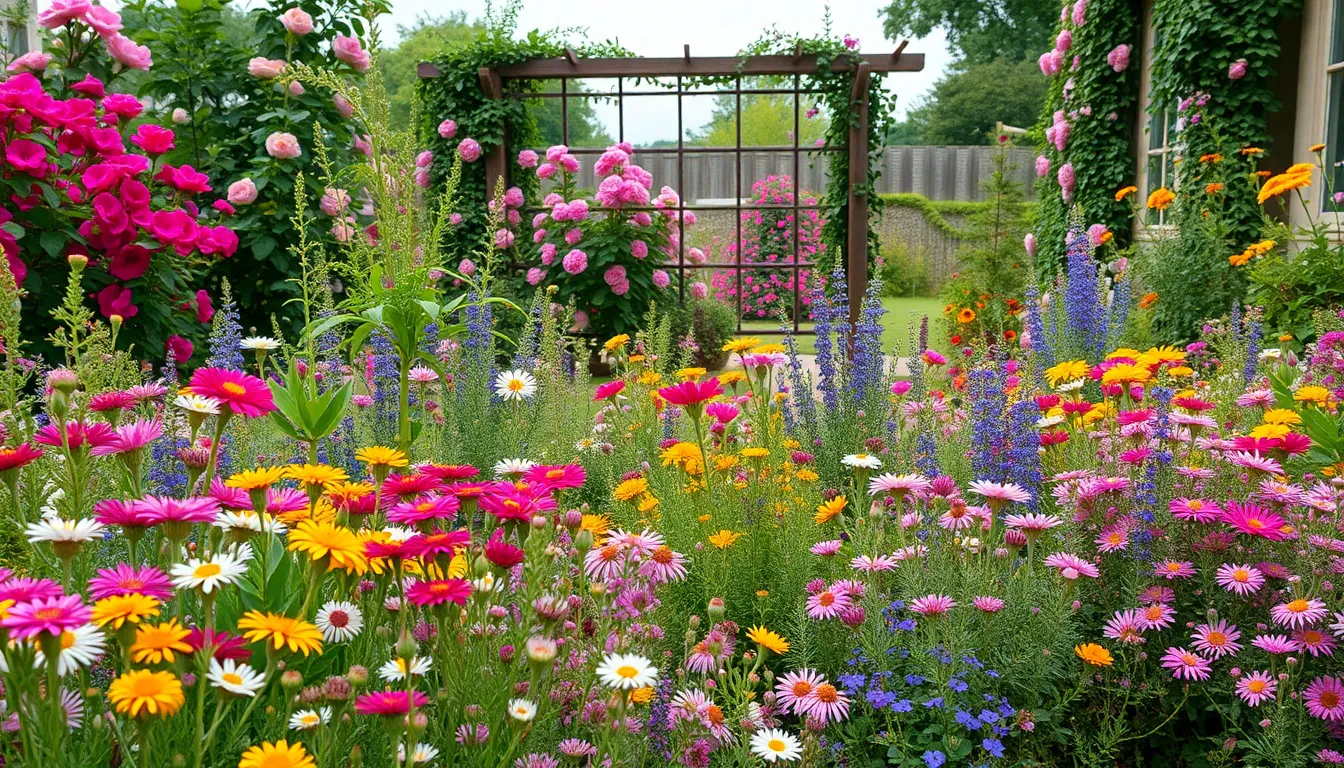
Creating cottage style flower beds brings that soft, romantic atmosphere we love in traditional country gardens. These beds showcase pastel shades and fragrant blooms nestled together in an informal, crowded arrangement that feels naturally abundant.
Mixed Perennial Borders with Wildflowers
Combining perennials with wildflowers gives us the most ever-changing and natural look for our country garden beds. Plants like dianthus, artemisia, and laurentia work beautifully together to create diverse displays of colors and textures throughout the growing season. We can plant these varieties close together using rich organic soil and mulch to maintain optimal soil health. This approach allows our gardens to evolve naturally while providing continuous blooms from spring through fall.
Herb Gardens with Fragrant Kitchen Essentials
Incorporating fragrant kitchen herbs transforms our flower beds into functional and sensory rich spaces. Rosemary, thyme, and lavender not only provide essential cooking ingredients but also add delightful fragrances that enhance the entire garden experience. We should plant these herbs along pathways or in designated sections of our flower beds to create inviting and practical growing areas. This strategy ensures we have easy access to fresh herbs while maintaining the cottage garden’s charming aesthetic.
Old-Fashioned Rose Gardens with Climbing Varieties
Traditional rose gardens featuring climbing varieties bring timeless elegance to our cottage style beds. English roses and old garden roses work perfectly with trellis or arbor structures that support their climbing growth patterns. We can incorporate classic garden elements like benches and statuary alongside these roses to complete the traditional country look. Supporting climbing roses with proper structures ensures healthy growth while creating stunning vertical displays that become focal points in our garden design.
Vintage Container Gardens Using Repurposed Materials
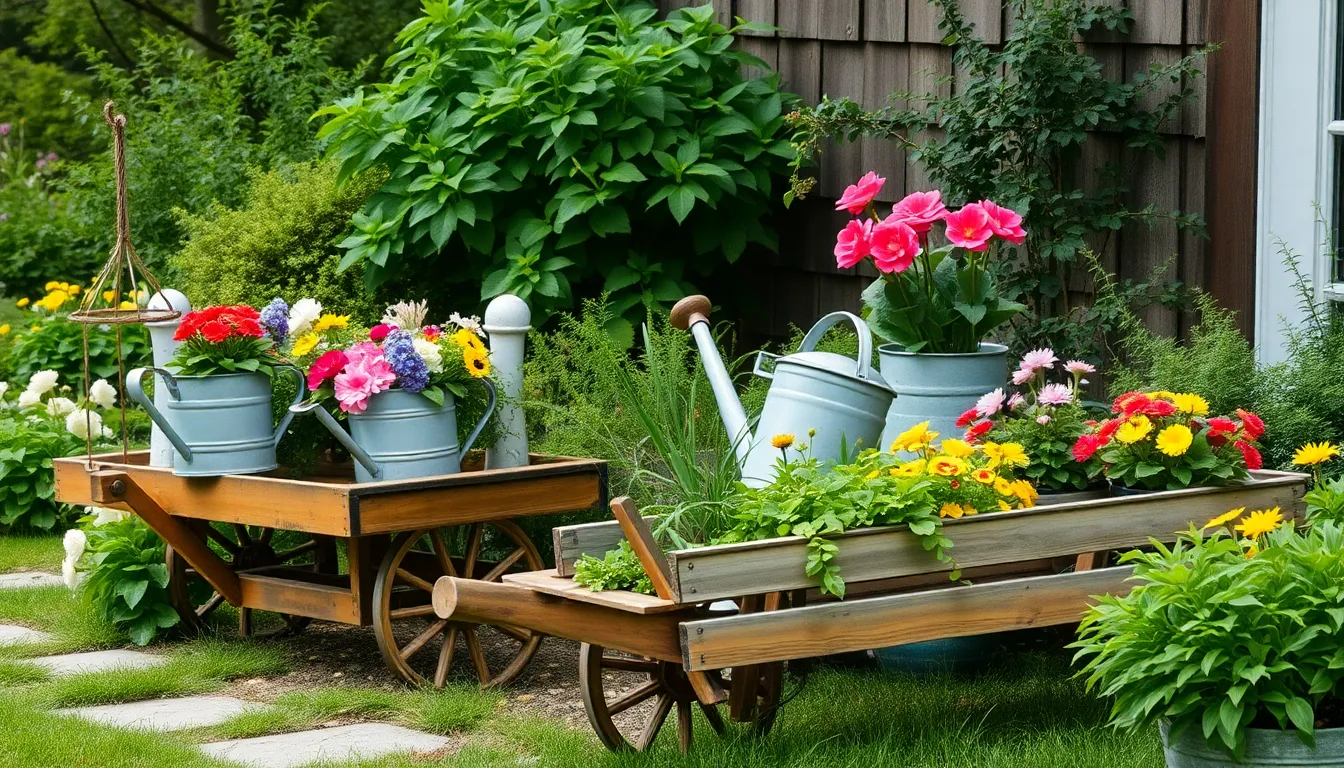
Repurposed containers add instant charm to our country gardens while reducing waste and saving money. These creative alternatives to traditional planters bring character and rustic appeal that perfectly complements the cottage garden aesthetic.
Galvanized Watering Cans as Planters
Galvanized watering cans transform into stunning planters that capture the essence of vintage country living. We love using these weathered metal containers for herbs like thyme, rosemary, and oregano, creating functional displays near kitchen entrances. Small flowering plants like petunias and marigolds thrive in these containers, adding bursts of color throughout the garden.
Drainage becomes essential when repurposing watering cans, so we drill several holes in the bottom to prevent waterlogged roots. Multiple sizes create visual interest when grouped together on patios, porch steps, or garden pathways. The naturally aged patina on older cans provides authentic charm that new containers simply can’t replicate.
Wooden Wheelbarrows for Mobile Garden Displays
Wooden wheelbarrows offer unmatched versatility as mobile planters that we can reposition throughout the seasons. These rustic containers work beautifully for seasonal flower displays, allowing us to move spring tulips to sunny spots and summer annuals to shadier areas as needed. The mobility factor makes maintenance easier and creates fresh focal points wherever we place them.
We fill wheelbarrows with potting soil and seasonal plants like pansies in spring, impatiens in summer, and mums in fall. The weathered wood adds rustic authenticity that complements stone pathways and cottage garden borders. Vintage wheelbarrows with chipped paint tell stories while serving as conversation pieces in our outdoor spaces.
Mason Jars and Tin Cans for Small Space Answers
Mason jars excel at creating charming displays for balconies, windowsills, and compact garden areas where space comes at a premium. We use these versatile containers for propagating plant cuttings, growing small succulents, and creating herb gardens on kitchen counters. Their transparent glass showcases root systems and adds visual interest to indoor growing projects.
Tin cans work perfectly for starting seedlings and growing compact plants like cherry tomatoes and small peppers. We remove labels, clean thoroughly, and punch drainage holes before planting. Painted tin cans in soft pastels or distressed finishes complement country garden color schemes while providing practical growing answers for apartment dwellers and small space gardeners.
Rustic Hardscaping Elements That Define Country Style
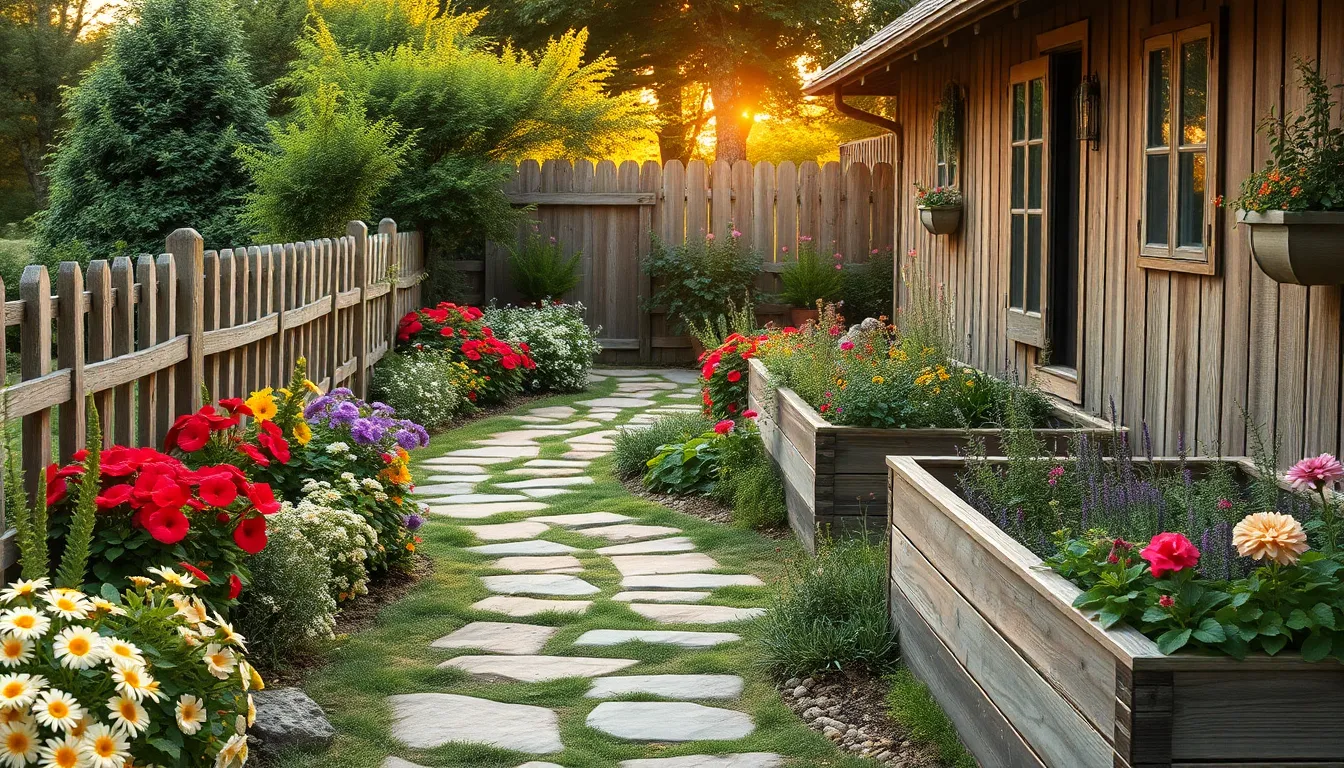
Building on our vintage container gardens, we need to establish the foundational elements that truly capture the essence of country style. Hardscaping provides the structural backbone that transforms any outdoor space into an authentic rustic retreat.
Natural Stone Pathways and Borders
Natural stone pathways create the perfect foundation for our country garden design. Fieldstone and bluestone blend seamlessly with surrounding landscapes while providing durable walking surfaces that age beautifully over time. We recommend using these materials to create meandering paths that guide visitors through different garden zones.
Borders constructed from natural stone add definition without creating harsh lines in our outdoor spaces. These organic elements complement the informal nature of country gardens while providing practical boundaries for planting areas. Stone borders work particularly well when paired with cottage garden plantings, creating visual contrast between structured hardscaping and flowing botanical displays.
Installing curved pathways enhances the informal charm we’re seeking in country garden designs. Winding routes encourage exploration and create intimate garden moments that straight walkways simply cannot achieve.
Split-Rail Fencing and Picket Fence Accents
Split-rail fencing delivers classic country charm while defining garden boundaries with rustic appeal. This traditional fencing style provides structure without blocking sightlines, maintaining the open feel that characterizes authentic country landscapes. We find split-rail designs particularly effective for separating different garden areas while preserving visual flow.
Picket fence accents add traditional charm to country garden spaces through their timeless design elements. These classic barriers work beautifully as backdrop features for cottage garden plantings or as charming entrances to exact garden rooms. White picket fences create striking contrasts against colorful flower displays, while weathered wood versions blend naturally with rustic surroundings.
Combining both fencing styles creates layered visual interest throughout our country garden designs. Strategic placement allows us to guide foot traffic while maintaining the informal atmosphere that makes country gardens so inviting.
Weathered Wood Raised Beds and Planters
Weathered wood raised beds provide the distressed, vintage appearance that defines authentic country garden style. These functional elements offer practical growing spaces while contributing to the overall rustic aesthetic we’re cultivating. Reclaimed barn wood and aged cedar deliver the weathered patina that makes new installations look established.
Raised bed construction using weathered materials solves drainage issues while creating focal points throughout our garden spaces. These elevated planting areas work particularly well for herb gardens and vegetable patches, combining functionality with country charm. We recommend varying heights and sizes to create visual rhythm across the industry.
Weathered wood planters extend our country theme to smaller garden areas and transition spaces. These versatile containers work beautifully for seasonal displays while maintaining the rustic character that ties our entire garden design together.
Traditional Country Garden Structures and Features
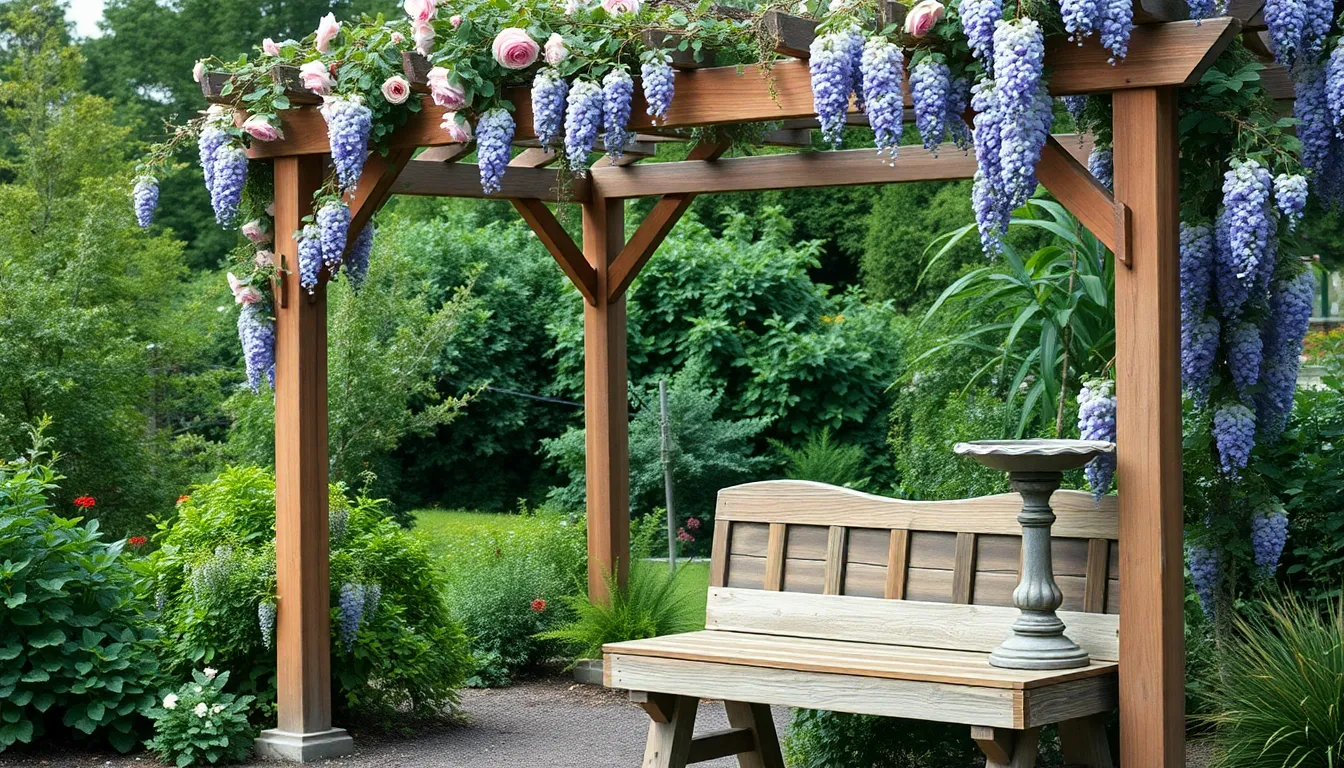
Building upon our foundational hardscaping elements, we’ll explore the architectural features that truly define traditional country garden charm. These structural elements create focal points while serving practical purposes in our rustic outdoor spaces.
Charming Garden Arbors and Pergolas
Garden arbors transform ordinary pathways into enchanting entrances that welcome visitors with natural beauty. We recommend positioning these wooden or metal structures at garden entry points where climbing plants like roses, clematis, or wisteria can flourish and add visual interest throughout the growing season. Pergolas extend this concept by creating larger overhead structures that define outdoor living spaces while providing essential support for vigorous climbing varieties.
Functionality meets aesthetics when we incorporate these vertical elements strategically throughout our country gardens. Arbors work perfectly as transitions between different garden rooms, while pergolas can frame seating areas or dining spaces. Both structures develop character over time as climbing plants mature and create natural canopies of fragrance and color.
Vintage-Inspired Garden Sheds and Potting Benches
Garden sheds constructed from rustic materials like weathered wood or corrugated metal serve dual purposes as storage answers and charming focal points. We suggest selecting designs that complement our existing hardscape elements while providing essential space for garden tools, supplies, and seasonal decorations. These structures can also function as small retreats where we escape daily routines and connect with nature.
Potting benches crafted from reclaimed wood materials offer convenient workspaces for plant preparation and garden maintenance tasks. Positioning these functional pieces near our main growing areas creates efficient workflows while maintaining the vintage aesthetic we’ve established. Traditional wooden benches develop beautiful patina over time that enhances their rustic appeal.
Classic Water Features Like Birdbaths and Wells
Birdbaths introduce movement and reflection that attract beneficial wildlife while creating peaceful focal points throughout our country gardens. We position these classic features where we can observe visiting birds from our favorite seating areas, choosing materials like stone or cast iron that weather naturally over time. The gentle sound of water adds sensory dimension that complements our fragrant herb plantings.
Decorative wells serve as nostalgic centerpieces that anchor our garden design with historical charm. These structures work beautifully as planting containers or simply as architectural elements that tell stories of simpler times. Wells create conversation pieces that guests remember long after visiting our rustic retreats.
Native Plant Selections for Authentic Regional Character
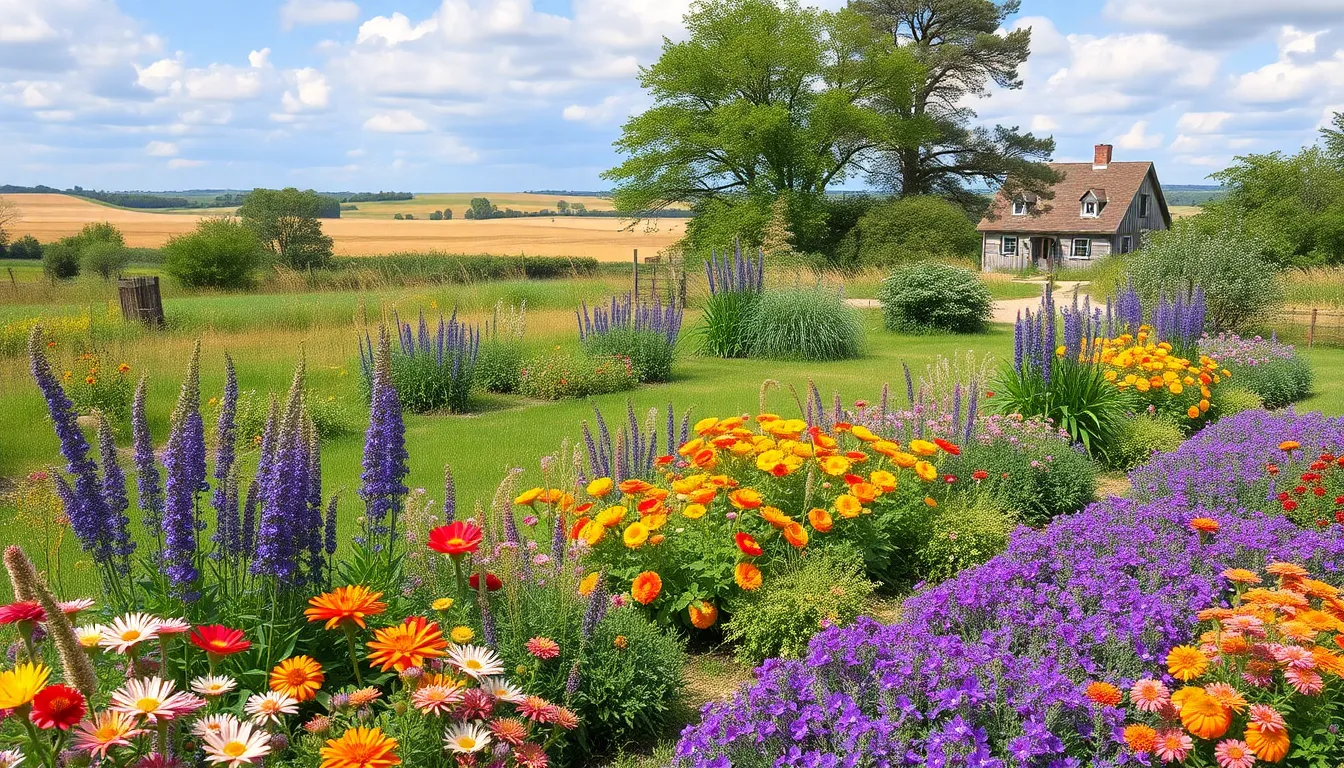
Choosing plants native to your exact region creates the foundation for an authentic country garden that thrives naturally. Regional native species are perfectly adapted to local soil conditions, climate patterns, and wildlife needs, making them incredibly resilient and low maintenance choices for busy gardeners.
Wildflower Meadows and Prairie Grasses
Wildflower meadows offer the ultimate sustainable landscaping solution that requires minimal watering and zero chemical fertilizers once established. Native wildflowers and prairie grasses create stunning displays while providing essential habitat for bees, butterflies, birds, and other beneficial wildlife that enhance your garden’s biodiversity.
Prairie grasses develop remarkably deep root systems that improve soil health by preventing erosion, improving water retention, and storing carbon to help combat climate change. We recommend considering your local climate conditions, expected plant sizes, and maintenance duration before full establishment when planning your meadow garden.
Established meadow gardens dramatically reduce traditional lawn maintenance needs while enriching the natural beauty of your country retreat. These self sustaining ecosystems become more beautiful each year as native species spread and create ever-changing seasonal displays.
Indigenous Trees and Shrubs for Natural Landscapes
Indigenous trees and shrubs provide the structural backbone that supports authentic country garden aesthetics while offering shelter and food sources for native wildlife. Local tree and shrub species typically require significantly less irrigation and chemical inputs compared to non native alternatives, making them environmentally responsible choices.
Native woody plants contribute to your garden’s unique sense of place while fulfilling essential ecological functions that support local ecosystems. Combining indigenous trees with wildflower meadows creates compelling vertical structure and provides year round seasonal interest through changing foliage, bark textures, and natural forms.
Strategic placement of native shrubs creates natural windbreaks, privacy screens, and wildlife corridors that connect your garden to surrounding natural areas. These living elements mature into stunning focal points that anchor your country garden design with authentic regional character.
Heirloom Vegetables in Kitchen Garden Plots
Heirloom vegetables connect us directly to regional agricultural heritage through time tested varieties that are often better adapted to local growing conditions than modern hybrids. Integrating these traditional cultivars into dedicated kitchen garden plots enriches biodiversity while delivering superior taste and nutritional qualities.
Pairing heirloom vegetables with native plant selections creates diverse, productive, and sustainable country gardens that celebrate both tradition and ecological wisdom. Many heirloom varieties have been selected over generations for their ability to thrive in exact regional climates and soil types.
Kitchen plots featuring heirloom tomatoes, beans, squash, and herbs become productive focal points that provide fresh ingredients while maintaining the authentic country aesthetic. These heritage vegetables often display unique colors, shapes, and flavors that modern varieties have lost through commercial breeding programs focused on shipping and storage rather than taste and nutrition.
Seasonal Country Garden Ideas for Year-Round Interest
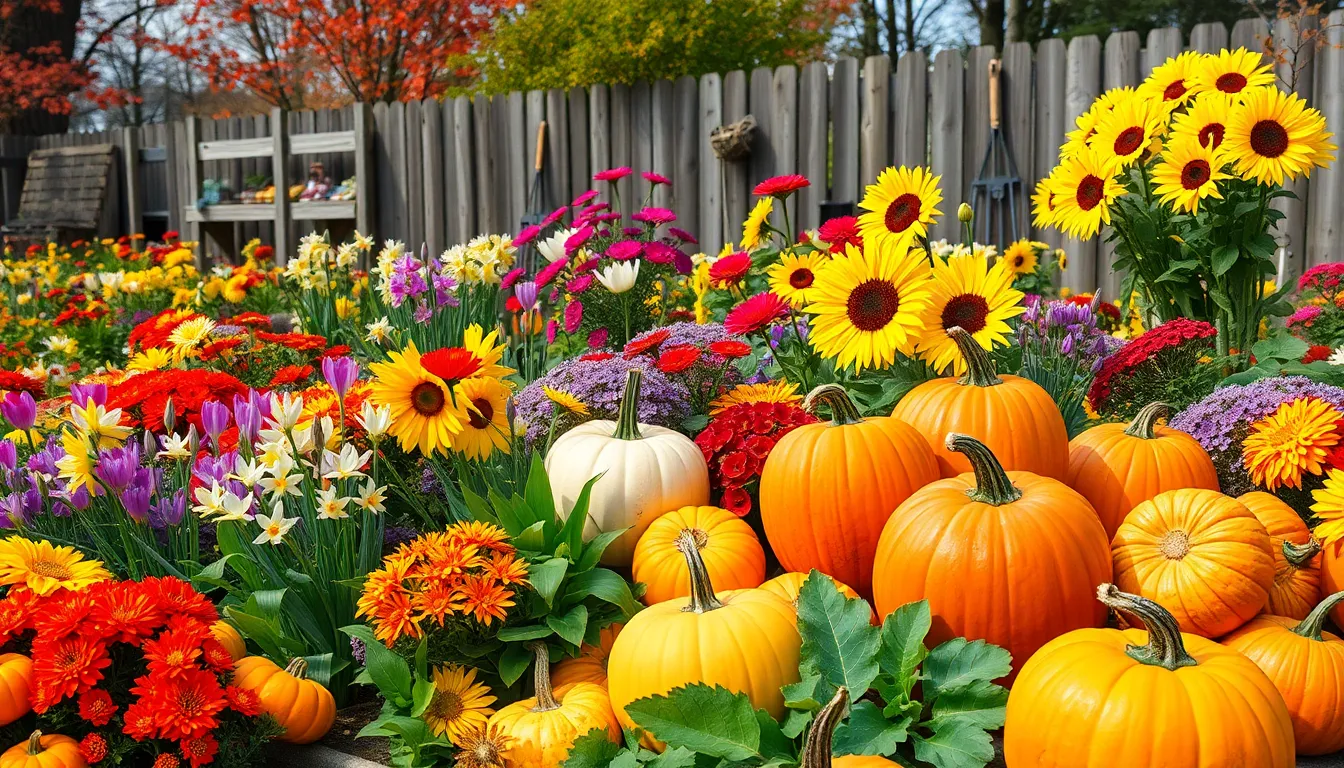
Creating a country garden with continuous appeal involves combining a strong structural backbone of shrubs and trees with flowering plants that bloom in succession through the seasons. We’ll ensure your garden maintains color, texture, and interest throughout the entire year.
Spring Bulb Displays and Early Bloomers
Spring bulb displays bring fresh color after winter’s dormancy through carefully planned early flowering combinations. We recommend planting hellebores with their colorful nodding flowers alongside traditional cottage garden bulbs for a charming transitional display. Japanese Kerria adds bright green bark interest while providing spring blooms that complement the seasonal awakening.
Early bloomers like crocuses, daffodils, and tulips create natural drifts when planted in informal groupings rather than rigid rows. We suggest combining these with spring flowering shrubs to establish vertical interest and extend the blooming period. Dense mixtures of ornamental and edible plants follow traditional cottage garden principles while ensuring vibrant early season displays.
Planting annuals and perennials together maximizes spring impact through layered blooming schedules. We focus on curvy natural lines rather than formal borders to achieve that authentic country garden charm that flows organically through the industry.
Summer Abundance with Sunflowers and Zinnias
Summer abundance reaches its peak with classic country garden plants like sunflowers and zinnias providing bright, bold colors throughout the growing season. We create lush displays by combining these statement flowers with continuous blooming perennials in informal dense planting layouts.
Sunflowers serve as natural focal points while attracting beneficial pollinators to support garden biodiversity. We recommend planting different varieties with staggered heights to create ever-changing visual layers that maintain interest from ground level to eye level and beyond.
Zinnias offer reliable summer color in vibrant shades that complement rustic garden themes perfectly. We plant them alongside cottage garden favorites to establish that cheerful atmosphere characteristic of traditional country landscapes. These hardy annuals thrive in dense plantings that maximize visual impact while requiring minimal maintenance once established.
Combining ornamental and edible varieties during summer months enriches both the garden’s beauty and its practical functionality. We emphasize continuous blooms that keep pollinators active while creating that abundant cottage garden feeling throughout the warmest months.
Fall Harvest Decorations and Autumn Colors
Fall harvest decorations transform country gardens into seasonal showcases featuring vibrant autumnal foliage and productive displays. We select shrubs and trees like paperbark maple for their textured bark and brilliant autumn colors that provide lasting visual interest.
Berry producing plants including dwarf persimmon, red twig dogwood, snowberries, and chokeberry offer seasonal fruit interest while supporting wildlife through winter months. We incorporate these into our planting schemes to ensure natural food sources complement decorative elements seamlessly.
Dried flower heads provide texture and architectural interest as plants transition into dormancy. We leave seed pods from plants like Autumn Joy sedum to persist into winter, creating natural decorative elements that require no additional maintenance.
Harvest themed decorations celebrate the season’s abundance through displays of pumpkins, gourds, and ornamental corn arranged among flowering plants. We combine these temporary elements with permanent plantings that offer autumn foliage colors, ensuring our country gardens remain beautiful even as growing seasons wind down.
DIY Country Garden Projects on a Budget
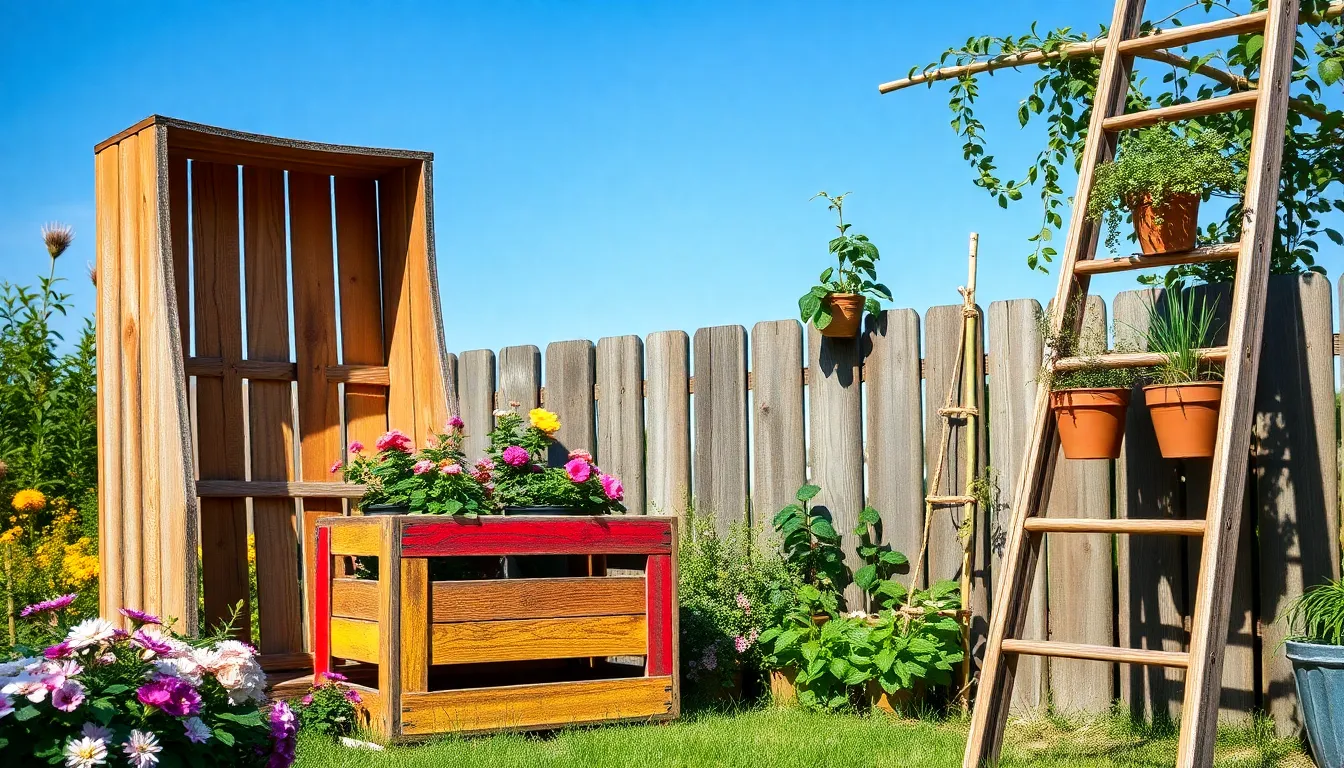
Creating a stunning country garden doesn’t require a massive budget when we embrace creative DIY answers. These affordable projects transform ordinary materials into charming garden features that capture authentic rustic appeal.
Homemade Garden Art from Salvaged Materials
Vintage croquet wickets bring unexpected charm when repurposed as decorative garden ornaments or plant supports throughout flower beds. We can position these antique sporting goods near climbing roses or use them to create whimsical pathways between garden sections.
Grapevine wreath pieces offer endless possibilities for creative garden displays when we break apart old wreaths. These natural elements work beautifully as rustic plant markers, miniature trellises for small climbing plants, or decorative borders around herb gardens.
Painted rock garden markers provide colorful identification for plants while adding personality to vegetable plots and herb gardens. We simply collect smooth stones from our property, paint them with weather-resistant colors, and label each with plant names using permanent markers.
Weathered barn wood scraps transform into charming garden signs when we sand them lightly and paint inspirational messages or plant information. These pieces add authentic country character while serving practical purposes in organizing garden spaces.
Upcycled Furniture as Garden Focal Points
Wooden crates serve multiple functions as rustic planters, garden storage, or display stands for potted plants. We can stack different sized crates to create tiered planting systems that maximize growing space in compact areas.
Repurposed pallets become versatile garden furniture when we sand them smooth and apply weather-resistant stain. These materials work perfectly for creating garden benches, vertical planters, or storage shelves that complement country garden aesthetics.
Old ladder shelves provide vertical growing space when we lean them against garden walls or fences. We can place potted herbs, small flowering plants, or decorative items on each rung to create eye-catching displays.
Vintage chairs make charming planters when we remove the seat and insert large pots or planting containers. These unique focal points work especially well near garden entrances or along walkways where they create conversation pieces.
Simple Trellis Systems for Climbing Plants
Bamboo stakes and twine create effective support systems for climbing vegetables like beans, peas, and cucumbers. We simply drive bamboo poles into the ground and connect them with natural twine in grid patterns that plants can easily climb.
DIY garden arches provide stunning entrances to different garden areas when we construct them using wooden or metal frames. These structures support climbing roses, clematis, or morning glories while creating defined transitions between garden spaces.
Tiered bamboo towers offer vertical growing answers for small spaces when we transform inexpensive tomato cages with bamboo stakes. We can wrap these structures with twine or wire mesh to support heavier climbing plants throughout the growing season.
Branch trellis panels use pruned limbs from our property when we lash them together with natural rope. These organic supports blend seamlessly with country garden designs while providing sturdy climbing surfaces for lightweight vines and flowering plants.
Conclusion
Your dream country garden is now within reach. We’ve shown you how to blend rustic charm with practical beauty using weathered wood elements cottage-style plantings and vintage containers. These timeless design principles work together to create an outdoor sanctuary that reflects your personal style.
Remember that the best country gardens evolve naturally over time. Start with one or two key elements like native wildflowers or a simple gravel pathway then gradually add features as your garden matures. The DIY projects and budget-friendly ideas we’ve shared make it possible to achieve stunning results without very costly.
Most importantly trust your instincts and let your garden tell its own story. The imperfect beauty of country style means there’s no wrong way to create your rustic retreat—just authentic expressions of nature’s charm.
Frequently Asked Questions
What makes a country garden different from other garden styles?
Country gardens emphasize natural, informal designs with wildflowers, rustic elements, and weathered materials. They feature cottage-style plantings, vintage containers, and meandering pathways that create a peaceful, authentic retreat. Unlike formal gardens, country gardens embrace organic shapes and native plants for a naturally abundant appearance.
Can I create a country garden in a small space?
Absolutely! Country gardens work beautifully in any size space. Use vintage containers like galvanized watering cans and mason jars for small-space solutions. Focus on cottage garden favorites in informal groupings, add weathered wood elements, and incorporate fragrant herbs to achieve authentic country charm.
Are country gardens high-maintenance?
No, country gardens are actually low-maintenance once established. By using native plants, wildflowers, and informal borders, you’ll create a sustainable garden that requires minimal upkeep. Native plants are well-adapted to local conditions and naturally thrive with less water and care.
What plants work best in country gardens?
Choose cottage garden favorites like hollyhocks, foxgloves, and climbing roses. Combine perennials with native wildflowers for dynamic color displays. Include fragrant herbs like rosemary, thyme, and lavender for sensory appeal and practical use. Heirloom vegetables also add authentic charm to kitchen garden areas.
How can I add rustic charm on a budget?
Repurpose vintage materials like wooden crates, old ladders, and galvanized containers as planters. Create pathways with gravel, use weathered wood for raised beds, and make DIY trellises with bamboo stakes. Paint rocks as garden markers and upcycle furniture for unique rustic displays.
What hardscaping elements define country garden style?
Natural stone pathways, split-rail fencing, and weathered wood raised beds create authentic rustic structure. Add garden arbors, vintage-inspired sheds, and classic water features like birdbaths. These elements provide functional framework while maintaining the organic, informal feel of country gardens.
How do I maintain year-round interest in my country garden?
Plant spring bulbs and early bloomers, summer annuals like sunflowers and zinnias, and structural shrubs for winter interest. Combine plants that bloom in succession throughout seasons. Add fall harvest decorations and evergreen elements to ensure your garden remains visually appealing year-round.

